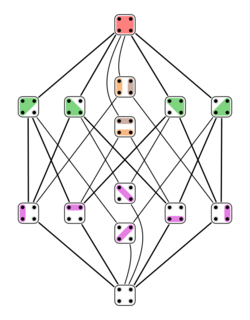Supersolvable lattice
In mathematics, a supersolvable lattice is a graded lattice that has a maximal chain of elements, each of which obeys a certain modularity relationship. The definition encapsulates many of the nice properties of lattices of subgroups of supersolvable groups.
Motivation
A finite group [math]\displaystyle{ G }[/math] is said to be supersolvable if it admits a maximal chain (or series) of subgroups so that each subgroup in the chain is normal in [math]\displaystyle{ G }[/math]. A normal subgroup has been known since the 1940s to be left and (dual) right modular as an element of the lattice of subgroups.[1] Richard Stanley noticed in the 1970s that certain geometric lattices, such as the partition lattice, obeyed similar properties, and gave a lattice-theoretic abstraction.[2][3]
Definition
A finite graded lattice [math]\displaystyle{ L }[/math] is supersolvable if it admits a maximal chain [math]\displaystyle{ \mathbf{m} }[/math] of elements (called an M-chain or chief chain) obeying any of the following equivalent properties.
- For any chain [math]\displaystyle{ \mathbf{c} }[/math] of elements, the smallest sublattice of [math]\displaystyle{ L }[/math] containing all the elements of [math]\displaystyle{ \mathbf{m} }[/math] and [math]\displaystyle{ \mathbf{c} }[/math] is distributive.[4] This is the original condition of Stanley.[2]
- Every element of [math]\displaystyle{ \mathbf{m} }[/math] is left modular. That is, for each [math]\displaystyle{ m }[/math] in [math]\displaystyle{ \mathbf{m} }[/math] and each [math]\displaystyle{ x \leq y }[/math] in [math]\displaystyle{ L }[/math], we have [math]\displaystyle{ (x\vee m)\wedge y=x\vee(m\wedge y). }[/math][5][6]
- Every element of [math]\displaystyle{ \mathbf{m} }[/math] is rank modular, in the following sense: if [math]\displaystyle{ \rho }[/math] is the rank function of [math]\displaystyle{ L }[/math], then for each [math]\displaystyle{ m }[/math] in [math]\displaystyle{ \mathbf{m} }[/math] and each [math]\displaystyle{ x }[/math] in [math]\displaystyle{ L }[/math], we have [math]\displaystyle{ \rho(m\wedge x)+\rho(m\vee x)=\rho(m)+\rho(x). }[/math][7][8]
For comparison, a finite lattice is geometric if and only if it is atomistic and the elements of the antichain of atoms are all left modular.[9]
An extension of the definition is that of a left modular lattice: a not-necessarily graded lattice with a maximal chain consisting of left modular elements. Thus, a left modular lattice requires the condition of (2), but relaxes the requirement of gradedness.[10]
Examples

A group is supersolvable if and only if its lattice of subgroups is supersolvable. A chief series of subgroups forms a chief chain in the lattice of subgroups.[3]
The partition lattice of a finite set is supersolvable. A partition is left modular in this lattice if and only if it has at most one non-singleton part.[3] The noncrossing partition lattice is similarly supersolvable,[11] although it is not geometric.[12]
The lattice of flats of the graphic matroid for a graph is supersolvable if and only if the graph is chordal. Working from the top, the chief chain is obtained by removing vertices in a perfect elimination ordering one by one.[13]
Every modular lattice is supersolvable, as every element in such a lattice is left modular and rank modular.[3]
Properties
A finite matroid with a supersolvable lattice of flats (equivalently, a lattice that is both geometric and supersolvable) has a real-rooted characteristic polynomial.[14][15] This is a consequence of a more general factorization theorem for characteristic polynomials over modular elements.[16]
The Orlik-Solomon algebra of an arrangement of hyperplanes with a supersolvable intersection lattice is a Koszul algebra.[17] For more information, see Supersolvable arrangement.
Any finite supersolvable lattice has an edge lexicographic labeling (or EL-labeling), hence its order complex is shellable and Cohen-Macaulay. Indeed, supersolvable lattices can be characterized in terms of edge lexicographic labelings: a finite lattice of height [math]\displaystyle{ n }[/math] is supersolvable if and only if it has an edge lexicographic labeling that assigns to each maximal chain a permutation of [math]\displaystyle{ \{ 1, \dots, n\}. }[/math][18]
Notes
- ↑ (Schmidt 1994)
- ↑ 2.0 2.1 (Stanley 1972)
- ↑ 3.0 3.1 3.2 3.3 (Stern 1999)
- ↑ (Stern 1999)
- ↑ (Stern 1999) (for semimodular lattices)
- ↑ (McNamara Thomas)
- ↑ (Stanley 2007) (for geometric lattices)
- ↑ (Foldes Woodroofe)
- ↑ (Stern 1999)
- ↑ (McNamara Thomas)
- ↑ (Heller Schwer)
- ↑ (Simion 2000)
- ↑ (Stanley 2007)
- ↑ (Sagan 1999)
- ↑ (Stanley 2007)
- ↑ (Stanley 2007)
- ↑ (Yuzvinsky 2001)
- ↑ (McNamara Thomas)
References
- Foldes, Stephan; Woodroofe, Russ (2021), "A Modular Characterization of Supersolvable Lattices", Proceedings of the American Mathematical Society 150 (1): 31–39, doi:10.1090/proc/15645
- Heller, Julia; Schwer, Petra (2018), "Generalized Non-crossing Partitions and Buildings", Electronic Journal of Combinatorics 25 (1), doi:10.37236/7200
- McNamara, Peter; Thomas, Hugh (2006), "Poset Edge-Labellings and Left Modularity", European Journal of Combinatorics 27 (1): 101–113, doi:10.1016/j.ejc.2004.07.010
- "Why the characteristic polynomial factors", Bulletin of the American Mathematical Society 36 (2): 113–133, 1999, doi:10.1090/S0273-0979-99-00775-2
- Schmidt, Roland (1994), Subgroup lattices of groups, de Gruyter Expositions in Mathematics, 14, Walter de Gruyter & Co., doi:10.1515/9783110868647, ISBN 3-11-011213-2
- "Noncrossing Partitions", Discrete Mathematics, Formal Power Series and Algebraic Combinatorics (Vienna 1997) 217 (1–3): 367–409, 2000, doi:10.1016/S0012-365X(99)00273-3
- "Supersolvable Lattices", Algebra Universalis 2: 197–217, 1972, doi:10.1007/BF02945028
- "An Introduction to Hyperplane Arrangements", Geometric combinatorics, IAS/Park City Mathematics Series, 13, American Mathematical Society, 2007, pp. 389–496, ISBN 978-0-8218-3736-8
- Stern, Manfred (1999), Semimodular Lattices. Theory and Applications, Encyclopedia of Mathematics and its Applications, 73, Cambridge University Press, doi:10.1017/CBO9780511665578, ISBN 0-521-46105-7
- Yuzvinsky, Sergey (2001), "Orlik–Solomon algebras in algebra and topology", Russian Mathematical Surveys 56 (2): 293–364, doi:10.1070/RM2001v056n02ABEH000383
 |

